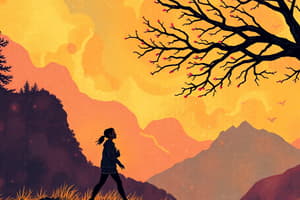Podcast
Questions and Answers
What themes are explored in 'Aunt Jennifer's Tiger'?
What themes are explored in 'Aunt Jennifer's Tiger'?
Marriage, oppression, symbolism, gender roles, and imagery
How is Aunt Jennifer's marriage portrayed in the poem?
How is Aunt Jennifer's marriage portrayed in the poem?
A quiet, unassuming union riddled with underlying pain and suffering
What does the tiger symbolize in 'Aunt Jennifer's Tiger'?
What does the tiger symbolize in 'Aunt Jennifer's Tiger'?
The inner turmoil and unspoken anger that Aunt Jennifer keeps concealed
How does the poem address gender roles?
How does the poem address gender roles?
What emotions does Aunt Jennifer experience in her marriage?
What emotions does Aunt Jennifer experience in her marriage?
What does the tiger symbolize in the poem?
What does the tiger symbolize in the poem?
How does the poem critique traditional gender roles?
How does the poem critique traditional gender roles?
What does the vivid imagery in the poem serve to highlight?
What does the vivid imagery in the poem serve to highlight?
What broader theme is highlighted through the transformation of the tiger into a domestic object?
What broader theme is highlighted through the transformation of the tiger into a domestic object?
What impact does the poem have on its readers?
What impact does the poem have on its readers?
Flashcards are hidden until you start studying
Study Notes
Title: Exploring "Aunt Jennifer's Tiger": Marriage, Oppression, Symbolism, Gender Roles, and Imagery
"Aunt Jennifer's Tiger," a poignant poem by Gwendolyn Brooks published in 1967, resonates deeply with themes of marriage, oppression, symbolism, gender roles, and imagery. The following discussion dives into these aspects of the poem, shedding light on its textual complexities and emotional depth.
Marriage
The poem centers on the lives of Aunt Jennifer and her husband, Mr. Johnson. Their marriage is presented as a quiet, unassuming union but riddled with underlying pain and suffering. The poem begins by describing Aunt Jennifer's daily routine, as she cooks, sews, and mends, her domestic duties representing the traditional role of women in 20th-century society. Throughout the poem, the reader senses the discontent and subjugation Aunt Jennifer experiences in her marriage, which is reinforced by the following lines:
And Beneath the stain of Martyrdom / She shapes. Upon the Sewing-Machine, Exalting the Mean
Oppression
The poem portrays a sense of oppression that Aunt Jennifer and her husband endure, particularly in the context of their relationship and the broader societal expectations. Aunt Jennifer's life is one of quiet acceptance and servitude to her husband, represented by the tiger she sews. This tiger symbolizes the inner turmoil and unspoken anger that Aunt Jennifer keeps concealed, reflecting the oppressive nature of her life.
Symbolism
The tiger serves as a potent symbol in the poem, representing Aunt Jennifer's repressed emotions and desires. The tiger, once a dangerous and powerful creature, is transformed into a domestic object through Aunt Jennifer's sewing, highlighting the broader theme of the taming of the wild spirit in women. This symbol is further reinforced by the lines:
The Tiger in the Tub, staring but not fond / And then she sews him to the end,/ That tiger, that dandified Purr
Gender Roles
"Aunt Jennifer's Tiger" critiques traditional gender roles and the expectations placed on women in the 20th century. Aunt Jennifer's life is one of housekeeping, and her husband's life is one of leisure and comfort. The poem questions the role of women in society and the impact of these roles on individual well-being.
Imagery
The poem's vivid imagery brings Aunt Jennifer's life to life, painting a picture of her daily routine and the emotional turmoil she endures. The sewing machine, the tiger, the tub of water, and the everyday objects that Aunt Jennifer handles are all depicted with striking clarity, creating a vivid and poignant scene. The poem's imagery also serves to highlight the contrast between Aunt Jennifer's mundane life and the wild, untamed nature of the tiger she sews.
In conclusion, "Aunt Jennifer's Tiger" is a powerful and poignant poem that explores themes of marriage, oppression, symbolism, gender roles, and imagery. Its exploration of the lives of Aunt Jennifer and Mr. Johnson offers a thoughtful and insightful critique of traditional gender roles and the societal expectations placed on women. Through its vivid imagery and evocative language, the poem creates a compelling narrative that captures the emotional complexity of Aunt Jennifer's life, forging a poignant and lasting impression on its readers.
Studying That Suits You
Use AI to generate personalized quizzes and flashcards to suit your learning preferences.

